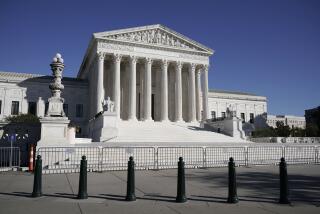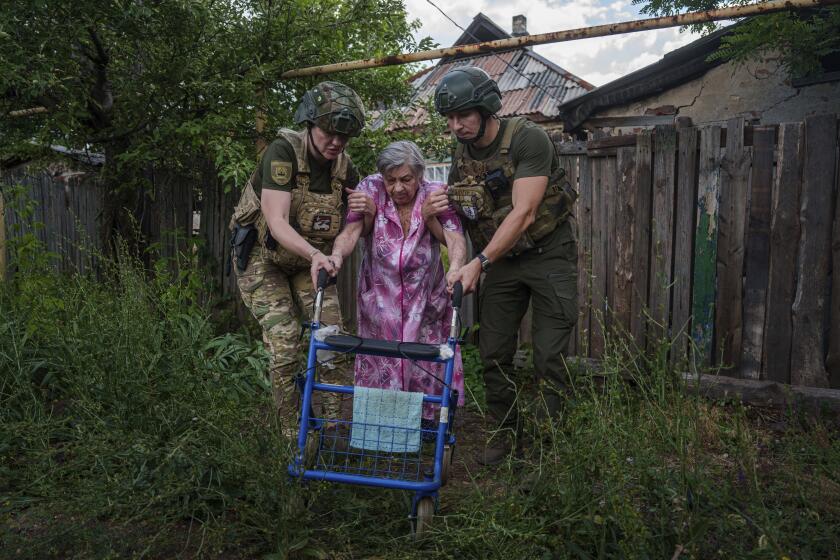A Hazy Horizon for New Orleans Public Housing
Wilbert Foucha sat on a stoop in the dead-quiet Iberville housing projects and watched as two rats scurried under a neighbor’s front door.
He shrugged his shoulders and chuckled. “It’s them human rats that we worried about,” he said.
Foucha, 67, was talking about the drug dealers and toughs who had made the Iberville a notoriously dangerous place before Hurricane Katrina. Now many of them are gone. But Foucha’s joke revealed only a sliver of his complex feelings about the Iberville projects, a weathered maze of brick buildings near the French Quarter that has been his home for more than a decade.
Today, no one is sure what the future will hold for most of the city’s 10 major housing projects. Six of them remain shuttered, whereas others, such as the Iberville, are being fixed up in stages.
When the levees broke, the Iberville’s grass and dirt courtyards filled with 3 feet of water, and nearly all of its residents scattered to outlying parishes and states.
Foucha pointed out that it wasn’t just the drug dealers who left, but the law-abiding people as well -- the restaurant workers and the schoolchildren and their mothers, who normally would have been out here yelling after them on a Thursday morning.
Foucha, like most pre-Katrina residents of the Iberville, is black, and he wants his black neighbors back. But he is frustrated that the Housing Authority of New Orleans, which manages the city’s public housing developments, is allowing Iberville residents to return only in a slow trickle as buildings are repaired and cleaned of mold.
So far, 187 of its approximately 600 pre-Katrina families have returned.
For Foucha, it is another troubling indicator that new plans are being made for the city without its African American poor.
“When they fix New Orleans up, you ain’t going to see too many black people living around here,” he said. “They going to be pushed out.”
Long before Katrina, Iberville and its sister projects were hulking totems to two of New Orleans’ defining concerns: the fear of crime and the fear that the destitute would be pushed out in the name of community revitalization.
A few years ago in the lower Garden District, the St. Thomas housing project -- one of the city’s most dangerous and blighted -- was torn down and replaced with new housing that mixed tenants who paid subsidized and market-rate rents. Though some cheered the move, others saw it as a way to muscle out the poor in a neighborhood that was planning for a new Wal-Mart.
Adonis Expose, a spokesman for the Housing Authority, said the agency remained committed to housing poor residents who lived in the city before the flood. But many specific plans for the shuttered projects are on hold as officials make larger decisions about which parts of New Orleans to redevelop.
But Katrina has increased calls to rethink the status quo.
City Council President Oliver M. Thomas Jr., who is black, recently said that only people who wanted to work should be allowed to return to the projects. In an interview with the New Orleans Times-Picayune, mayoral candidate Peggy Wilson, who is white, called the projects “poverty beds, drug beds and crime beds” and called for fresher approaches to housing the poor.
The Iberville projects have posed a particularly vexing problem for New Orleans. The New Deal-era buildings were constructed on the former site of Storyville, the red-light district that helped New Orleans earn a reputation for jazz and licentious good times.
These days, the French Quarter endures in that role, but the Iberville existed on its northwestern lank as a threat to the tourist business that was increasingly important to the city’s economy. New Orleans Police Officer Desmond Pratt, who has walked the courtyards of the Iberville for years, said tourists regularly wandered across Basin Street into the projects and were often assaulted. Others were led there by residents and robbed. Crime also spilled out into the Quarter.
Residents also preyed on their neighbors. In some cases, Pratt said, innocents did not cooperate with police. That was often because the Iberville was webbed with multiple generations of extended families -- and people were wary to inform on, say, a wayward cousin.
Pratt and his colleagues said they were working hard before Katrina to rid the Iberville of crime. In the last few years, they set up a hot line for anonymous tipsters, and football and karate programs for children.
And yet, before Katrina hit Aug. 29, the Iberville was still an extremely dangerous place. Police Capt. Louis Colin said there were five murders in the projects in 2005.
There has been one murder case this year, and some residents aren’t sure whether things are going to get better.
Trenice Jones, 36, pointed to rows of apartments abandoned by Katrina evacuees that she said were now occupied by troublemaking squatters living off the grid.
There is still too much crime for the few residents who are back, she said. “And the ones that’s doing it is staying in those vacant apartments.”
Pratt said the police were aware of the problem and were working with housing officials to solve it.
A small group of local business owners on the edge of the French Quarter are working on a plan they call “Iberville Rebirth,” a public-private partnership that would extensively renovate the existing buildings and open them up to some market-rate housing.
One proponent of the idea is Michael Valentino, who is opening a private cultural and welcome center in a former train depot on nearby Basin Street. Under the plan, he said, former Iberville residents would be welcome back. He figures that only half of the original residents will want to return -- which means that no one will be displaced by the new market-rate housing.
“Iberville is in a critical location, at the cultural and business core of the city,” he said. “We are trying to craft a responsible redevelopment plan for Iberville ... so it can be a viable, vibrant and safe neighborhood.”
Valentino said that he had met with a small group of residents, and that most in the project hadn’t heard about it Thursday.
But they passed along strange rumors. Foucha said he heard that Donald Trump wanted to buy the place.
“I’d like to see things be better than they were, and people live happily ever after,” Foucha said -- as long as he could guarantee that he would be one of those people.
More to Read
Start your day right
Sign up for Essential California for news, features and recommendations from the L.A. Times and beyond in your inbox six days a week.
You may occasionally receive promotional content from the Los Angeles Times.






